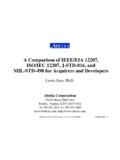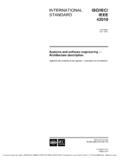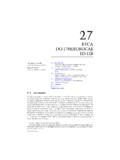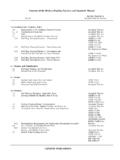Transcription of ISO standards ISO 12207, ISO 15504 & ISO 9126 - CETIC
1 1 ISO standardsISO standardsISO 12207 , ISO 15504 & ISO 9126 ISO 12207 , ISO 15504 & ISO 9126 ISACA CETIC Meeting23 May 20072 IntroductionIntroductionISO 12207 = common framework for the lifecycle of the software Architecture of the software lifecycleprocesses ( processes , activities, tasks)ISO 15504 also known as SPICE (Software Process Improvement andCapability Determination) = "frameworkfor the assessment of software processes " Derived from 12207 and CMMIP rocessProcessstandardsstandards3 Introduction (2)Introduction (2)ISO 9126 = set of characteristics to describe software product quality Internal, external and use-related features Each characteristic = subcharacteristics + metric to assess conformance withrequirementsProductProductstandardst andard4 ISO 12207 ISO 12207 Software Software lifecyclelifecycleprocessesprocesses5 AgendaAgenda1. Context and Purpose2. Scope3. History4. Basic conceptsISO 1220761.
2 1. ContextContextandandPurposePurposeDomain : software engineeringFocus : software lifecycle processesPurpose : to establish a common framework for the life cycle of software to foster mutual understanding among business parties to acquire, supply, develop, operate and maintain softwareISO 1220772. Scope2. ScopeStakeholders: acquirers, suppliers, users etcApplication: corporate processes related to project products and project servicesISO 12207 covers process definitions and descriptions ISO 1220783. 3. HistoryHistoryISO 1220793. 3. HistoryHistory(2)(2)ISO/IEC 12207 Sponsor: Joint Technical Committe 1 (JTC1) (Information Technology) of International Organization for Standardization (ISO) and International Electrotechnical Commission 7 (IEC). Developer: Subcommittee 7 (SC7) (Software Engineering)Proposed in June 1988 Published 1 August 1995 Participants: Australia, Canada, Denmark, Finland, France, Germany, Ireland, Italy, Japan, Korea, Netherlands, Spain, Sweden, UK, USAISO 12207104.
3 Basic Concepts 4. Basic Concepts LifeLifecycle cycle andandarchitecturearchitectureISO 1220711 ModularityCohesion (Functional): Tasks in a process must be functionally relatedCoupling (Internal): Links between processes must be minimalAssociationIf a function is used by more than one process, then the function becomes a process in itselfIf Process X is invoked by Process A and Process A only, then Process X belongs to Process AResponsibilityEach process is under a responsibilityA function with parts under different responsibilities shall notbe a process4. Basic Concepts 4. Basic Concepts RulesRulesfor for partitioningpartitioningthethelifelifecy clecycleISO 12207124. Basic Concepts 4. Basic Concepts TheTheProcessProcessTreeTreeISO 1220713A process is partitioned into PDCA activities based on the PDCA-cycle principles4. Basic Concepts 4. Basic Concepts RulesRulesfor for partitioningpartitioninga a processprocessISO 1220714An activity is divided into tasks, which are grouped into similar actionsBased on TQM PrinciplesEach party/participant has appropriate responsibility4.
4 Basic Concepts 4. Basic Concepts ActivityActivityandandTasksTasksISO 1220715 Not certifyingNot prescriptive, no how-tosNot a standard for methods, techniques & modelsdoes not prescribe management and engineering methodsdoes not prescribe computer languagesEtcNot a standard for metricsmany tasks need metrics and indicatorsbut prescribes no specific metrics/indicatorsreferences ISO/IEC 9126 for guidance4. Basic Concepts 4. Basic Concepts WhatWhat12207 12207 isisnotnot16 ISO 15504 (SPICE)ISO 15504 (SPICE)Software Software QualityQuality17 AgendaAgenda1. Context and Purpose2. History3. Basic concepts4. CETIC products derived from ISO 15504 ISO 15504181. 1. ContextContextandandPurposePurposeNormal ized structure devoted to managingrequirements related to a software development processModel for process management + set ofrequirements/guidelines to assess/improvethose processesISO 15504192. 2. HistoryHistoryEarly 1990 s: process improvement andcapability determination methodsdeveloped in several countries International consensus on the urgent need for a public domain standar for software processassessmentJune 1991 in London, Joint TechnicalCommittee 1/Sub-Committee 7 of theISO/IEC: resolution to develop an international standard on software processassessmentISO 15504203.
5 Basic concepts 3. Basic concepts --ProcessProcess5 process categoriesCustomer-Provider Acquisition process (process for selectiong provider) Process for support to customerEngineering Process for analyzing requirements and designing the systemSupport Documentation processManagement Risk management processOrganization Process for managing human resourcesISO 15504213. Basic concepts 3. Basic concepts --ProcessProcess6 maturity levels for assessing the processes5 : optimizing4 : quantitatively managed3 : defined2 : managed1 : initial0 : incompleteTo assess a process, we define it as follows:Purpose/goalResults/attributes that should be met to reach a successful implementation of the processISO 15504223. Basic concepts 3. Basic concepts --ProcessProcessandandmaturitymaturityle velslevels(2)(2)6 niveaux de maturit 5 : en optimisation4 : pr visible3 : tabli2 : g r 1 : r alis 0 : incompletExample: process for software testing(1/2)Purpose: to test the integrated software Result of a successful implementation of the processAcceptance criteria are developed in order to verify compliancewith requirementsThe integrated software is verified using the defined acceptancecriteriaThe testing results are taken inA non-regression strategy is established in order to test theintegrated software again if software is modifiedThe regression testing is performed when necessaryISO 15504233.
6 Basic concepts 3. Basic concepts --AssessingAssessingeacheachprocessproce ssFor each attribute:N = not implementedP = partly implementedL = largely implementedF = fully implementedA level is achieved if The attribute(s) of this level = or FAttributes of lower levels = F 0% 15 % 16 % 50 % 51 % 85 % 86 % 100 %LFISO 15504243. Basic concepts 3. Basic concepts --ExampleExampleofofprocessprocessassess mentassessmentRequirements analysisdesignbuildingtestingQuality assuranceconfiguration managementlevel =>achieved level121001 ISO 15504253. Basic concepts 3. Basic concepts --ConclusionConclusionSPICE is very interesting to prepare an improvement planCan be applied to the way a team worksGives the opportunity to deployprogressivelythe action plan:By targeting first and foremost the most criticalprocessesBy targeting the levels in ascending order On a mid-term: target = level 2 On a long term: target = level 3 ISO 15504264.
7 CETIC 4. CETIC productsproducts--OWPL OWPL (Observatoire Wallon des Pratiques Logicielles)(Observatoire Wallon des Pratiques Logicielles)Model based on CMM and SPICE (ISO 15504 )Adapted to SMO sgoal:improve software production processesISO 15504274. CETIC 4. CETIC productsproducts--OWPL (2)OWPL (2)model structure: 10 processes (each split up in practices): requirements management, project planification, project follow-up, development, documentation, test, configuration management, outsourcing management, quality managemenet, process for capitalizing knowledgeSuccess factors organized in 4 categories: organization within the processes take place, the management policy, the human resources the used technical toolsISO 15504284. CETIC 4. CETIC productsproducts--OWPL (3)OWPL (3)Success story: PEPITeCETIC has assessed the PEPITo software withOWPLGoal: inform PEPITe about their software development practices to improve them Improve their products and servicesCETIC has provided a complete assessmentreport + recommendations to improve theirdevelopment practicesISO 15504294.
8 CETIC 4. CETIC productsproducts--NOEMINOEMI based on existing standards such as ISO/IEC15504 The NOEMI assessment method has been developed by Centre HENRI TUDOR (Luxemburg).Two goals: improve the perception of computer maturity in SMO sor VSMO smethodological tool for improving those companies SIISO 15504304. CETIC 4. CETIC productsproducts--NOEMI (2)NOEMI (2)Assessment according to an exhaustive list of thetypical computer activities in SMO s/VSMO s dividedin 5 fields: infrastructuresupportmanagementsecurityd ocumentationISO 15504314. CETIC 4. CETIC productsproducts--NOEMI (3)NOEMI (3)Success Story: GREISCH (Li ge), Architects officeInterviews conducted with 3 types of users: One responsible within the computer department The director of the computer department 3 end-users (architects) CETIC has provided GREISCH with an assessment report on their practices within the computer department andthe quality of the services/products delivered to the end-users (the architects) by the computer scientistsCETIC has also provided recommendations to improvetheir products and services32 ISO 9126 ISO 9126 Software Software ProductProductQualityQuality33 AgendaAgenda1.
9 Scope2. History3. Basic concepts4. CETIC products derived from ISO 9126 ISO 912634 ISO 9126is an international standardfor the evaluationof software. It will be overseen by the project SQuaRE, ISO 25000:2005, which follows the same general conceptsfour parts: quality model; external metrics; internal metrics; and quality in use Scope1. ScopeISO 912635 Late 1980 s: need for a framework assessingthe quality of a software product1991: Joint Technical Committee of theISO/IEC develops ISO 9126 Standard revised in 2001 Will be overseen by SQuaRE (ISO 25000:2005)2. 2. HistoryHistoryISO 9126363. Basic concepts 3. Basic concepts FirstFirstpartpartThe quality model established in the first part of the standard, ISO 9126-1, classifies software qualityin a structured set of characteristics and sub-characteristics as follows:ISO 9126373. Basic concepts 3. Basic concepts FirstFirstpartpartISO 9126383. Basic concepts 3.
10 Basic concepts FirstFirstpart (2)part (2)Functionality-A set of attributes that bear on the existence of a set of functions and their specified properties. The functions are those that satisfy stated or implied set of attributes that bear on the capability of software to maintain its level of performance under stated conditions for a stated period of set of attributes that bear on the effort needed for use, and on the individual assessment of such use, by a stated or implied set of 9126393. Basic concepts 3. Basic concepts FirstFirstpart (3)part (3)Efficiency-A set of attributes that bear on the relationship between the level of performance of the software and the amount of resources used, under stated set of attributes that bear on the effort needed to make specified set of attributes that bear on the ability of software to be transferred from one environment to 9126403. Basic concepts 3. Basic concepts FirstFirstpart (4)part (4)Each quality sub-characteristic (as adaptability) is further divided into attributes.





